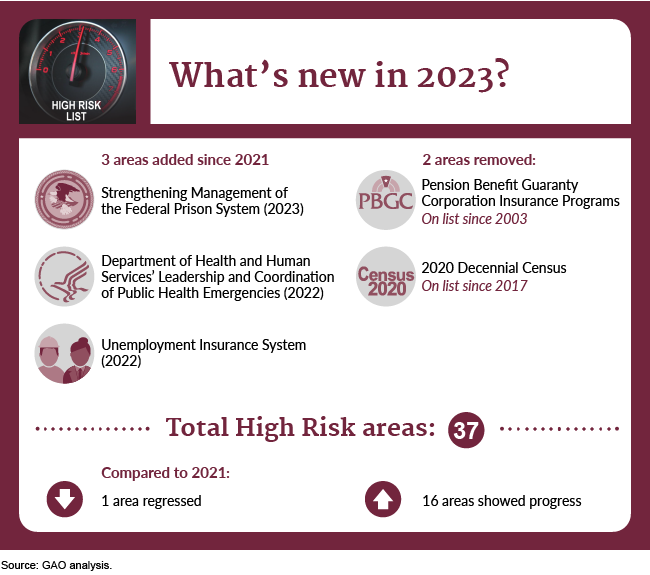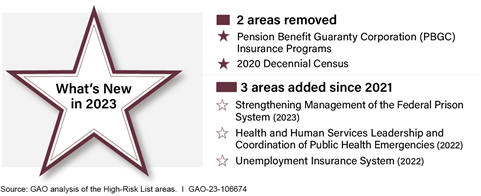High-Risk Series: Efforts Made to Achieve Progress Need to Be Maintained and Expanded to Fully Address All Areas
Fast Facts
This testimony discusses an update to our High Risk List—which highlights 37 areas across the federal government that are vulnerable to waste, fraud, abuse, and mismanagement, or that need broad reform.
Overall, 16 areas on our list improved—including VA health care and the Postal Service. One area—DOD's business systems modernization—regressed. We also removed two existing areas—the 2020 decennial census and pension benefit programs.
We added the federal prison system partly due to its longstanding issues with managing staff and resources, and planning and evaluating programs that help incarcerated people successfully return to the community.

Highlights
What GAO Found
Congress and executive agencies have made substantial progress addressing high-risk issues since the previous High-Risk List update in 2021. Sixteen of 34 high-risk areas improved since 2021. This is the most progress in the 8 years since GAO started rating high-risk areas. Two of the 16 areas are being removed from the list: Pension Benefit Guaranty Corporation (PBGC) Insurance Programs and the 2020 Decennial Census. Since our last update, there were approximately $100 billion in financial benefits due to improvements in high-risk areas.
Changes to the High-Risk List Since 2021

The PBGC Insurance Programs area is being removed because Congress provided funding to troubled multiemployer pension plans, which has led to an improved financial position for the PBGC multiemployer insurance program. Additionally, the financial position of the PBGC single-employer insurance program has improved gradually in recent years. PBGC now projects a very low risk of insolvency over the next 15 years for both programs. GAO will continue to monitor the funds.
The 2020 Decennial Census is being removed because the Census Bureau made progress in addressing data quality concerns, chartered a high-level governance group, and implemented priority recommendations. GAO will monitor 2030 Census planning—already underway—for emerging risks and challenges.
GAO is adding one new area to the 2023 High-Risk List: Strengthening Management of the Federal Prison System. This area is being added, in part, due to the Bureau of Prisons' long-standing challenges managing staff and resources, and planning and evaluation programs that help incarcerated people have a successful return to the community.
In 2022, GAO added two other areas to the High-Risk List. The Department of Health and Human Services' (H H S) Leadership and Coordination of Public Health Emergencies was added because, for more than a decade, GAO has found persistent deficiencies in HHS's leadership role preparing for and responding to public health emergencies, including those that result from extreme weather events. GAO added the Unemployment Insurance System area because administrative and program integrity challenges in the joint federal-state program have affected the system's ability to meet the needs of unemployed workers. These challenges also expose the system to significant financial losses.
GAO's 2023 High-Risk List
|
High-risk area |
Change since 2021 |
|---|---|
|
Strengthening the Foundation for Efficiency and Effectiveness |
|
|
Strategic Human Capital Management |
↑ |
|
Managing Federal Real Property |
● |
|
Funding the Nation's Surface Transportation Systema, b |
n/a |
|
Modernizing the U.S. Financial Regulatory Systema |
● |
|
Resolving the Federal Role in Housing Financea |
● |
|
USPS Financial Viabilitya |
↑ |
|
Management of Federal Oil and Gas Resources |
● |
|
Limiting the Federal Government's Fiscal Exposure by Better Managing Climate Change Risksa |
↑ |
|
Improving the Management of IT Acquisitions and Operations |
● |
|
Improving Federal Management of Programs that Serve Tribes and Their Members |
↑ |
|
U.S. Government's Environmental Liabilitya |
↑ |
|
Emergency Loans for Small Businessesc |
n/a |
|
Strengthening Management of the Federal Prison System (new)b |
n/a |
|
Transforming DOD Program Management |
|
|
DOD Weapon Systems Acquisition |
● |
|
DOD Financial Management |
● |
|
DOD Business Systems Modernization |
↓ |
|
DOD Approach to Business Transformation |
↑ |
|
Ensuring Public Safety and Security |
|
|
Ensuring the Cybersecurity of the Nationa |
↑ |
|
Strengthening Department of Homeland Security IT and Financial Management Functions |
● |
|
Ensuring the Effective Protection of Technologies Critical to U.S. National Security Interests |
↑ |
|
Improving Federal Oversight of Food Safetya |
● |
|
Protecting Public Health through Enhanced Oversight of Medical Products |
● |
|
Transforming EPA's Process for Assessing and Controlling Toxic Chemicals |
↑ |
|
Government-wide Personnel Security Clearance Process |
● |
|
National Efforts to Prevent, Respond to, and Recover from Drug Misusec |
n/a |
|
HHS Leadership and Coordination of Public Health Emergencies (new in 2022)b |
n/a |
|
Managing Federal Contracting More Effectively |
|
|
Acquisition and Program Management for DOE's National Nuclear Security Administration and Office of Environmental Management |
↑ |
|
NASA Acquisition Management |
↑ |
|
DOD Contract Management |
● |
|
VA Acquisition Management |
↑ |
|
Assessing the Efficiency and Effectiveness of Tax Law Administration |
|
|
Enforcement of Tax Lawsa |
● |
|
Modernizing and Safeguarding Insurance and Benefit Programs |
|
|
Medicare Program and Improper Payments |
● |
|
Strengthening Medicaid Program Integritya |
● |
|
Improving and Modernizing Federal Disability Programs |
● |
|
National Flood Insurance Programa |
↑ |
|
Managing Risks and Improving VA Health Care |
↑ |
|
Unemployment Insurance System (new in 2022)b |
n/a |
Legend: ↑ indicates area progressed on one or more criteria since 2021; ↓ indicates area declined on one or more criteria ; ● indicates no change; n/a = not applicable
Source: GAO. | GAO-23-106674
aLegislation is likely to be necessary to effectively address this high-risk area.
bNot rated because this high-risk area is newly added or primarily involves congressional action.
cRated for the first time because this high-risk area was newly added in 2021.
Why GAO Did This Study
The federal government is one of the world's largest and most complex entities. About $6.3 trillion in outlays in fiscal year 2022 funded a broad array of programs and operations. GAO's High-Risk Series identifies government operations with vulnerabilities to fraud, waste, abuse, and mismanagement, or in need of transformation.
This biennial update describes the status of high-risk areas, outlines actions that are needed to ensure further progress, and identifies new high-risk areas needing attention by the executive branch and Congress.
Lasting solutions to high-risk problems save billions of dollars, improve service to the public, and strengthen government performance and accountability. In the past 17 years, financial benefits totaled $675 billion.
GAO uses five criteria to assess progress in addressing high-risk areas: (1) leadership commitment; (2) agency capacity; (3) an action plan; (4) monitoring efforts; and (5) demonstrated progress.
Recommendations
Executive branch agencies need to address hundreds of open GAO recommendations to bring about lasting solutions to the 37 remaining high-risk areas. Continued congressional oversight is essential to achieve greater progress and legislation is needed in some cases.
